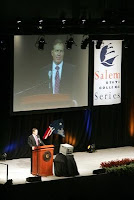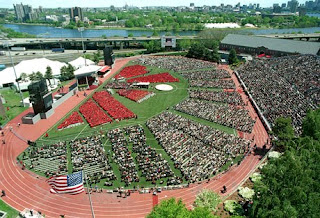1-How big of a stage do I need?
2-What height should the stage be?
3-Do I need the stage dressed?
4-Can the stage be installed/removed during business hours?
5-What is the physical location of the stage?
6-Can I use a self-install style stage?
1-Stage size is determined by what you put on it.

A common size for a band stage is 12' x 16' which allows enough room for a drum set, keyboard, and two to three additional performers (maybe a vocalist, and two guitars). But the number of band members as well as the size of the instruments are what will dictate the stage size (think grand piano). Any supporting equipment which needs to be on the stage such as speaker monitors should also be factored in.
A dance performance may have a number of dancers, and depending on the style of dance, may require a significant size stage. For a lecture with one speaker you can get by with a much smaller stage (8' x 8') because there may be just a lectern with the speaker standing behind it.
Aside from the performers and their equipment, any other items like flags, backdrops and decor should be considered.
If you are new to stages, then it is good to talk to the band or performers to get an idea of their space requirements.
Rent only as much stage as the performance requires and monitor the items on top of the stage which you can control. Maybe only the drums need to be up higher than the floor, or the floral decorations may rest in front of the stage on tables (or the floor). Some items may even be eliminated to keep the stage cost in the budget.
2-Stages can be built to many heights.

The expected size of the audience generally determines how high you want your stage to be. With an audience of 200 - a 16" or 24" high stage is fine. When that number becomes 2000, you may want a 32" to 48" high stage. Some small audiences could use a stage only 8" high.
The height your stage needs to be could hinge on the size of the room if a ramp is required. Since a ramp has to have an incline of a one inch drop over the length of twelve inches, a 48 inch high stage would need a 48 foot long ramp and because that length is greater than 30 feet, you need a landing which brings the total length to 52 feet minimum. Alternatively, a sixteen inch high stage needs only a sixteen foot ramp. In some instances, the ramp could dwarf the size of the stage and the cost of the stage.
Higher stages require more material and labor to make them high. Additional railings, bracing, tools and labor will all conspire to drive your stage cost up - so keep your stage as low as possible - especially when a ramp is required.
3-Dressing Down Your Stage.

A
Fully Dressed Stage includes Skirting, Carpet, and a Drape Backdrop as well as Floral, Greenery, and other Decor.
The deck on many rental stages is made of wood and is painted black or grey. For many events this would suffice - especially for a Rock Band. By choosing not to have carpet, the money savings could be used in other areas of your event.
In the same way, skirting could be eliminated for a band stage. If the sides of a stage must be skirted, you may be able to take care of it yourself by taping inexpensive black plastic around the three sides facing the audience.
Backdrops, and other decor may not be a necessity for many types of events.
By managing the finishing on your stage, you will be managing your budget.
4-Scheduling Your Stage Install & Removal.
While many venues (or multi-purpose areas) have tightly scheduled events, you would be surprised how early the room may be available for an installation. Conversely, many times the removal could have been pushed to the next day instead of the night of the event.
Printed or online policies may be just guidelines. Call and talk to the scheduling person about a particular event you are running - you may find the policy is a lot looser than you thought. Sometimes it pays to check the schedule as the date nears - there may be a cancelled event or activity which opens the room up.
By allowing the Stage Rental Company to install and remove during their regular business hours, you will be saving yourself a lot of extra labor dollars.
5-Location, Location, Location.

This is not only the realtor's creed, it may cost you money for your stage install.
Selecting a location that is not readily accessible by truck or won't allow the stage to be "dollied" in will mean the Stage Rental Company will have to hand-carry it. The extra labor required will cost more in dollars (and in time if your event schedule is tight).
Surfaces that are sloped or uneven may require the stage to be levelled, which means additional materials (and labor) for legs, braces and railings as the ground falls away.
Since labor is not cheap, it makes a lot of sense to consider the impact the location will have on the installation and removal of your stage.
6-Self-Install Stages.
Any rental item normally installed by the Rental Company is always less expensive if you install it. Not every Rental Company will let you install their equipment, but some equipment is designed with you in mind, and many companies will have it for you.
Self-install stages (also called platforms or risers) are like oversize folding tables. They have one or more sets of folding legs attached to them which you fold out and lock to get the height you need. You then put them side by side to create the size stage you want.
They are best used on flat, even floor or ground as there is normally no adjustment in the legs. Some styles have hardware on them that allows them to hook together so they won't separate while being used. For dance performances, Platforms may not be the best choice because the dance moves may cause the platform panels to shift and separate - talk to your Stage Rental Company expert to determine if this is a viable option for your performance.
This is by far the best alternative for a low budget event. You provide all the labor, so the cost is half of what it would be to get a professionally installed stage. You may have to provide skirting for the sides of the stage but that is a small price to pay.
Having the ability to self-install (and remove) also sidesteps many scheduling issues which translates into dollar savings by avoiding additional labor costs.
Mark
Saponaro Email me
camelotspecialevents.com  Ask yourself:
Ask yourself: 
 The expected size of the audience generally determines how high you want your stage to be. With an audience of 200 - a 16" or 24" high stage is fine. When that number becomes 2000, you may want a 32" to 48" high stage. Some small audiences could use a stage only 8" high.
The expected size of the audience generally determines how high you want your stage to be. With an audience of 200 - a 16" or 24" high stage is fine. When that number becomes 2000, you may want a 32" to 48" high stage. Some small audiences could use a stage only 8" high.
 This is not only the realtor's creed, it may cost you money for your stage install.
This is not only the realtor's creed, it may cost you money for your stage install.


Great Information. I need this.
ReplyDeleteFor additional information, if you need The Best Syncronize Genset Rental Service in Indonesia for event in Indonesia, you can try to reach us Arthur Teknik.
Thanks admin.
Regards,
Blogger.
Your eventstaging rentalsneed to be of the best quality as it will be the first and the last thing your audience will remember about your event.
ReplyDeleteYour monitor rental event staging rentals need to be of the best quality as it will be the first and the last thing your audience will remember about your event.
ReplyDeletenew chapter financial solutions
ReplyDelete